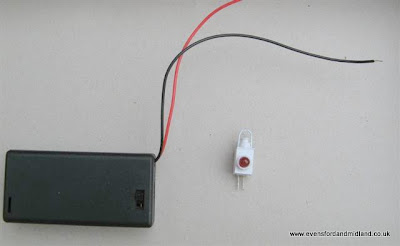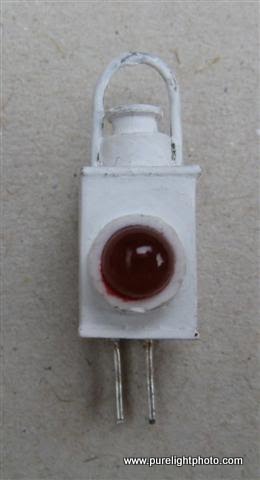by JSJ My railway is required to have a head and tail lamp on each train. Working lamps always look better and I do run in the dusk fairly regularly so it's great if the lamps can work. Trains are not allow to run without a head and tail lamp. Lamps are only permitted on the first and last vehicle of the train. White (or yellow) at the front and red at the rear. The lamp bodies are all white. The lamps available from GRS and Chuffed2bits work but only have tiny watch batteries in them so don't last all that long. 15 minutes to half an hour is my experience. I wanted something to last much longer. This is my solution. Some may have seen it on GScaleMad.
The lamp is built round a 5mm LED
Here are the basic components.
The battery box has two AAs and a switch.
The lamp is made of plastic strip and box section with a 5 mm LED built in. I don't have any pictures of the detail of the construction but I will take some next time I make some more lamps. OK I know it's not that pretty but it does a job of work. The two LED terminals are bent through 90 degrees and cut level so they stick out of the bottom of the lamp.
The lamp sockets are made from printed circuit board sockets which have the same spacing as the LED terminals. I suspect this is not a complete coincidence.
Here is a socket on the back of my Hartland-based brake.
And here is another ont he back of my Brandbright brake carriage
Battery box in place. The carriage is still on its first set of AAs after two years. They also power the coach lighting. The LEDs are so bright I use the biggest value resistor which will still allow them to light, so the current is so low that the batteries last forever (literally so far in this case)
Carriage rolled out of the works for an shot of the working lamp.
The Baldwin uses the same type of lamp and has a socket front and rear. It uses the traction batteries for powering the lamps. These use a "warm white" LED which I would say is nearer a gas lamp colour than an oil lamp. Mostly I sue yellow LEDs for oil lamps.
Update 11 May 10 JSJ More details of the sockets. These are actually one lead with two identical sockets one on each end, cut in half. Doug:
I used some 10mm LEDs and the GRS Loco Lamp casting:
|
Workshop >

.jpg)
.jpg)





